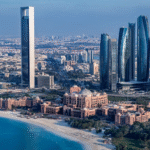Now Reading: Smart Mobility in Real Estate: Developers Lead Change
-
01
Smart Mobility in Real Estate: Developers Lead Change
Smart Mobility in Real Estate: Developers Lead Change

The rise of smart mobility in real estate is reshaping the way cities are built and how people move within them. As urban populations grow and traffic congestion worsens, traditional transport systems are struggling to meet the needs of modern life. Real estate developers across the world, and especially in the UAE, are responding by integrating mobility solutions directly into new communities and developments.
From electric vehicle (EV) charging hubs and cycling-friendly neighborhoods to autonomous shuttle services and mobility-as-a-service (MaaS) platforms, these innovations are redefining the relationship between property and transport.
Why Smart Mobility Matters in Real Estate
Smart mobility is more than just a buzzword. It represents a fundamental shift in how transportation is designed to be sustainable, efficient, and integrated into urban environments. For real estate developers, mobility has become a core part of master planning, offering:
- Convenience: Residents can access multiple transport options within walking distance.
- Sustainability: Lower emissions align with green building goals.
- Property Value: Integrated mobility raises the attractiveness of real estate investments.
- Future-Proofing: Smart mobility ensures developments stay relevant as technology advances.
The UAE as a Hub for Smart Mobility Innovation
The UAE has become a global leader in adopting futuristic urban planning, making it a perfect testing ground for smart mobility. Initiatives such as Dubai’s Autonomous Transportation Strategy aim for 25% of trips to be driverless by 2030. Similarly, Abu Dhabi and Sharjah are investing in EV infrastructure, cycling tracks, and smart public transport systems.
Real estate developers are playing a crucial role in supporting these goals.
How Developers Are Integrating Smart Mobility Solutions
1. Electric Vehicle (EV) Infrastructure
One of the most visible integrations is the rollout of EV charging stations across residential and commercial projects. Developers now:
- Install fast-charging stations in parking garages.
- Offer incentives for residents who purchase EVs.
- Designate parking spots exclusively for electric cars.
For example, communities like Dubai Sustainable City feature widespread EV charging access, making car ownership greener and more affordable.
2. Cycling and Walking-Friendly Communities
Developers are redesigning neighborhoods to encourage non-motorized transport. This includes:
- Dedicated cycling lanes.
- Pedestrian-first layouts.
- Car-free zones within residential clusters.
Tilal Al Ghaf in Dubai and Masdar City in Abu Dhabi are leading examples of developments where walking and cycling are prioritized.
3. Autonomous Shuttles and Smart Buses
Driverless transport is no longer futuristic-it’s becoming reality. Some communities are introducing autonomous shuttle services that connect residents to schools, retail hubs, and metro stations. These vehicles:
- Reduce traffic congestion.
- Offer eco-friendly alternatives to private cars.
- Enhance last-mile connectivity.
Dubai’s Expo City, for instance, is expected to be a hub for autonomous mobility trials.
4. Mobility-as-a-Service (MaaS) Platforms
Developers are beginning to partner with tech companies to provide integrated mobility apps. Residents can book rides, check bus timings, rent e-scooters, or reserve EV charging slots all from one platform. MaaS systems simplify commuting while reducing reliance on private vehicles.
5. Smart Parking Systems
Finding parking in crowded urban areas is a major challenge. Smart parking solutions now allow residents and visitors to:
- Reserve parking via apps.
- Get real-time updates on availability.
- Reduce emissions from cars circling for spots.
This integration not only improves convenience but also supports sustainability by cutting unnecessary fuel use.
6. Logistics and Delivery Hubs
With the boom in e-commerce, developers are also creating smart logistics zones within residential communities. This includes:
- Drone delivery stations.
- Centralized package lockers.
- Shared logistics hubs for faster delivery.

These solutions reduce congestion caused by delivery vans while adding convenience for residents.
Benefits for Residents and Investors
Integrating smart mobility in real estate offers advantages for both residents and investors:
- For Residents:
- Reduced commuting stress.
- Lower transportation costs.
- Healthier lifestyles through walking and cycling.
- For Investors:
- Higher rental demand for connected communities.
- Increased long-term property values.
- Alignment with ESG-focused global investment trends.
Challenges to Implementation
While the potential is huge, developers face several challenges:
- High Costs: Infrastructure for EVs, autonomous vehicles, and MaaS platforms requires heavy upfront investment.
- Adoption Barriers: Residents may be slow to switch to new mobility options.
- Technology Risks: Rapid advancements may outpace current infrastructure.
Still, with government backing and strong demand for sustainable solutions, these barriers are being addressed quickly.
Global Examples Shaping the UAE
- Singapore’s Smart Nation program integrates mobility with real estate, serving as a model for urban efficiency.
- Stockholm’s MaaS projects highlight how shared mobility can replace car ownership.
- Los Angeles’ smart parking programs are helping reduce congestion in dense urban districts.
The UAE often adapts global best practices and scales them with speed and ambition, meaning residents benefit from world-class solutions.
The Future of Smart Mobility in Real Estate
Looking ahead, the next phase will likely include:
- Fully autonomous communities where private car ownership is rare.
- Hyperloop and advanced transit hubs integrated into real estate projects.
- AI-powered traffic management to optimize urban flow.
- Green mobility credits where residents earn rewards for choosing sustainable transport.
As these innovations take hold, real estate developers will increasingly act as mobility providers, not just builders.
Conclusion: A New Era for Real Estate
The rise of smart mobility in real estate shows how developers are rethinking their role in shaping modern life. By integrating EV infrastructure, cycling lanes, autonomous shuttles, and MaaS platforms, they are creating communities that are convenient, sustainable, and future-ready.
For the UAE, these projects align perfectly with national visions for sustainability and innovation, making the country a global leader in connected living. For residents and investors, the message is clear: mobility is no longer just about getting from one place to another – it is about redefining the very fabric of urban communities.
Follow us on: Instagram
Read More:-Dubai Secondary Market Prices Soar as Sellers Push






















